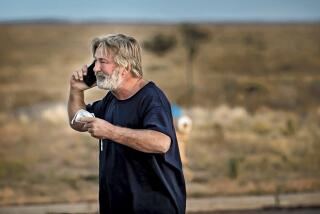Firing of 16-Inch Guns on Battleships Halted : Navy Orders Moratorium Pending Investigation of Blast on Iowa; Safety Issues to Be Key Focus
- Share via
WASHINGTON — One day after an explosion ripped through a gun turret aboard the battleship Iowa killing 47 sailors, the Navy on Thursday ordered that firing of the 16-inch guns on all four U.S. battleships be halted until an investigation of the blast is completed.
The Navy’s investigation is expected to focus on a welter of safety issues related to the 1940s-vintage guns, which are considered among the most destructive of the Navy’s conventional weapons but also among the most complex and dangerous to operate.
Navy officials said that all of the immediate eyewitnesses to the disaster were killed. Only 11 of 58 seamen encased in the seven-story-high turret survived the blast and subsequent fire, Pentagon spokesman Fred S. Hoffman said.
The survivors all worked in the lowest level of the heavily fortified turret, where silk-wrapped 110-pound sacks of explosive powder and munitions were stored. They escaped the turret through special hatches, said Cmdr. Mark Baker, a Navy spokesman.
The dead included three Californians: Brian Wayne Gendron, 20, a seaman apprentice from Madera; Geoffrey Scott Schelin, 20, a seaman from Costa Mesa, and James Darrell White, 22, a gunner’s mate 3rd class from Norwalk.
The bodies were airlifted to the Roosevelt Roads U.S. Naval Station on Puerto Rico Thursday as the Iowa approached the island, 330 miles from where the disaster occurred in the Atlantic Ocean. The dark silhouette of the Navy helicopters matched the mood of the base commanders, who repeatedly said that they were stunned by the tragedy aboard the Iowa.
“That is a very sad sight,” Rear Adm. John A. Moriarity, commander of Naval activities in the Caribbean, said at Roosevelt Roads. “And this has been a very sad day. A tragic day.”
From there, the Iowa headed back to its home port at Norfolk, Va., while the bodies of the dead were flown to the military mortuary at Dover Air Force Base in Delaware, where a memorial service was conducted.
At the White House, Chief of Staff John H. Sununu said that President Bush will attend a memorial service in Norfolk Monday. He said that the President had heard of the service and told his staff that “if it could be fitted in, he wanted to be there.”
Bush, speaking to a small group of reporters at the White House Thursday, said that the Navy’s investigators should “check out all procedures to be sure that safety is at the highest point.”
The Navy’s official investigative team is headed by Adm. Richard D. Milligan, a former skipper of the battleship New Jersey. Milligan and the three other uniformed naval investigators boarded the Iowa as it was anchored 15 miles off the coast of Puerto Rico.
Navy officials revealed Thursday that the explosion on the Iowa appears to have occurred immediately behind the middle gun in the second of the two forward turrets as the gun was being loaded with ammunition for its first practice shot of a gunnery exercise.
Vice Adm. Jerome L. Johnson, who observed Wednesday’s exercise aboard the Iowa, said in Puerto Rico Thursday that the explosion occurred “during the process of loading the guns.”
Johnson, commander of the U.S. 2nd Fleet, described a “tremendous explosion and fire. . . . The explosion was instantaneous.”
The investigators are expected to look at a variety of safety issues related to the Iowa’s giant 16-inch guns, which are capable of hurling shells as heavy as small cars for more than 20 miles.
Two years ago, the guns on the Iowa and its three sister battleships were equipped with newly designed O-ring seals that sometimes melted when the guns were fired.
Problem With Rubber Seals
Capt. Alfred Becker, a Navy spokesman, acknowledged that some of the earliest synthetic rubber seals, which were designed to block the escape of hot gases from the 16-inch guns when they were fired, broke down too easily. A subsequent redesign by the Navy’s Sea Systems Command also wore out prematurely, Becker said.
But Becker said that the latest version of the O-rings, developed in November, 1987, has exhibited no signs of premature wear. He added that there were “no blow-outs” while the faulty O-rings were in place.
The Navy also is expected to examine other safety concerns that are related to the 16-inch gun but do not appear to have played a part in Wednesday’s tragedy.
Experts said that sailors are well aware of the dangers involved in the complex process of loading and firing the 16-inch guns, the largest in the Navy’s inventory. One described the complex loading and firing sequence as an intricate and potentially deadly ballet in which hand signals are used to communicate vital safety information.
Safeguards Lacking
“There are no safeguards built into the turret to cover mistakes,” then-Lt. Bob Lian, No. 2 turret officer aboard the battleship New Jersey, said in a 1984 article published by the Navy in Surface Warfare magazine.
“The operation is inherently dangerous not only because of the size of the projectiles but because so much coordination is necessary,” Lian added.
In a 1987 issue of Surface Warfare, Cmdr. Larry E. Penix, then head of gun systems in the Navy’s surface combat systems division, warned of two potential safety hazards in the 16-inch gun turret.
Penix said that the absence of forced-air ventilation in the compartments where the explosive powder is handled could lead to a buildup of dangerous but non-explosive nitroglycerin gas.
The Navy acknowledged Thursday that while the 16-inch guns are firing, air ventilation is shut off to the powder compartments to isolate them in case of an explosion. A Navy spokesman said that a new ventilation system for the space is being explored.
Heat Buildup in Chamber
Finally, Navy officers have focused on the safe limits of heat buildup in the chamber of the gun when firing. Penix warned: “If you get a jammed gun or a misfire, and the projectile is in a hot barrel, it may cook off,” or explode.
“We need studies to know when that is going to occur and develop procedures to ensure our sailors’ safety,” Penix added.
A Navy spokesman said that the “hot-gun” conditions could occur only during intense periods of shelling. He added that Navy training manuals include a series of procedures that sailors should follow in such cases.
Staff writer Kenneth J. Garcia contributed to this story from Puerto Rico.
More to Read
Sign up for Essential California
The most important California stories and recommendations in your inbox every morning.
You may occasionally receive promotional content from the Los Angeles Times.











